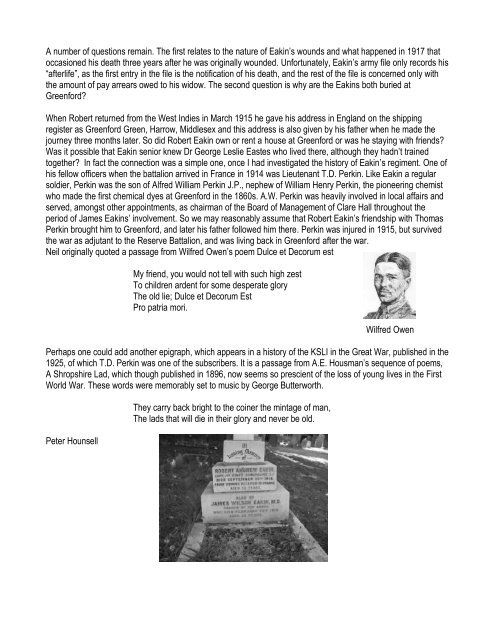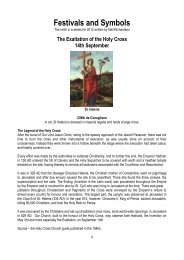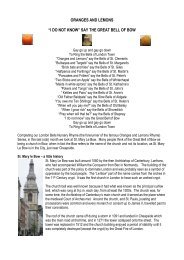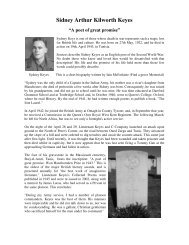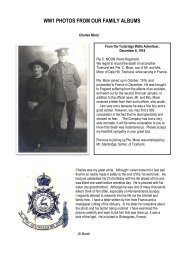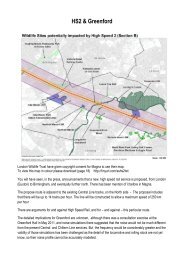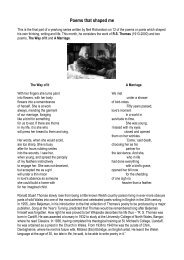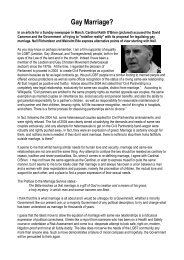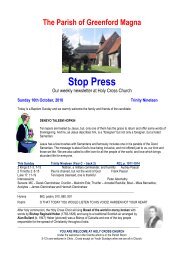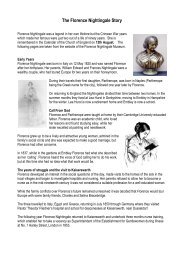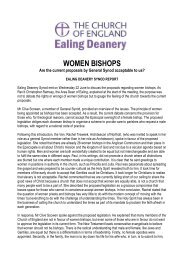Robert Andrew Eakin - The Parish of Greenford Magna
Robert Andrew Eakin - The Parish of Greenford Magna
Robert Andrew Eakin - The Parish of Greenford Magna
Create successful ePaper yourself
Turn your PDF publications into a flip-book with our unique Google optimized e-Paper software.
A number <strong>of</strong> questions remain. <strong>The</strong> first relates to the nature <strong>of</strong> <strong>Eakin</strong>’s wounds and what happened in 1917 that<br />
occasioned his death three years after he was originally wounded. Unfortunately, <strong>Eakin</strong>’s army file only records his<br />
“afterlife”, as the first entry in the file is the notification <strong>of</strong> his death, and the rest <strong>of</strong> the file is concerned only with<br />
the amount <strong>of</strong> pay arrears owed to his widow. <strong>The</strong> second question is why are the <strong>Eakin</strong>s both buried at<br />
<strong>Greenford</strong>?<br />
When <strong>Robert</strong> returned from the West Indies in March 1915 he gave his address in England on the shipping<br />
register as <strong>Greenford</strong> Green, Harrow, Middlesex and this address is also given by his father when he made the<br />
journey three months later. So did <strong>Robert</strong> <strong>Eakin</strong> own or rent a house at <strong>Greenford</strong> or was he staying with friends?<br />
Was it possible that <strong>Eakin</strong> senior knew Dr George Leslie Eastes who lived there, although they hadn’t trained<br />
together? In fact the connection was a simple one, once I had investigated the history <strong>of</strong> <strong>Eakin</strong>’s regiment. One <strong>of</strong><br />
his fellow <strong>of</strong>ficers when the battalion arrived in France in 1914 was Lieutenant T.D. Perkin. Like <strong>Eakin</strong> a regular<br />
soldier, Perkin was the son <strong>of</strong> Alfred William Perkin J.P., nephew <strong>of</strong> William Henry Perkin, the pioneering chemist<br />
who made the first chemical dyes at <strong>Greenford</strong> in the 1860s. A.W. Perkin was heavily involved in local affairs and<br />
served, amongst other appointments, as chairman <strong>of</strong> the Board <strong>of</strong> Management <strong>of</strong> Clare Hall throughout the<br />
period <strong>of</strong> James <strong>Eakin</strong>s’ involvement. So we may reasonably assume that <strong>Robert</strong> <strong>Eakin</strong>’s friendship with Thomas<br />
Perkin brought him to <strong>Greenford</strong>, and later his father followed him there. Perkin was injured in 1915, but survived<br />
the war as adjutant to the Reserve Battalion, and was living back in <strong>Greenford</strong> after the war.<br />
Neil originally quoted a passage from Wilfred Owen’s poem Dulce et Decorum est<br />
My friend, you would not tell with such high zest<br />
To children ardent for some desperate glory<br />
<strong>The</strong> old lie; Dulce et Decorum Est<br />
Pro patria mori.<br />
Wilfred Owen<br />
Perhaps one could add another epigraph, which appears in a history <strong>of</strong> the KSLI in the Great War, published in the<br />
1925, <strong>of</strong> which T.D. Perkin was one <strong>of</strong> the subscribers. It is a passage from A.E. Housman’s sequence <strong>of</strong> poems,<br />
A Shropshire Lad, which though published in 1896, now seems so prescient <strong>of</strong> the loss <strong>of</strong> young lives in the First<br />
World War. <strong>The</strong>se words were memorably set to music by George Butterworth.<br />
Peter Hounsell<br />
<strong>The</strong>y carry back bright to the coiner the mintage <strong>of</strong> man,<br />
<strong>The</strong> lads that will die in their glory and never be old.


